Ci sono stati momenti in cui tutto sembrava a posto in WordPress, ma il link del post mostrava un errore 404. Nessuna modifica al contenuto, solo una pagina mancante che avrebbe dovuto esserci.
Questo di solito compare dopo aver modificato le impostazioni, cambiato tema o aggiunto codice che influisce silenziosamente sui permalink. Può coglierti di sorpresa, soprattutto se il resto del tuo sito funziona perfettamente.
Ogni volta che ci imbattiamo in errori 404 inaspettati, seguiamo un semplice processo per ripristinare gli URL dei post, senza congetture o complicate risoluzioni dei problemi. Ed è esattamente quello che condividiamo con te in questa guida.
Sarai in grado di correggere gli errori 404 e assicurarti che i tuoi post vengano caricati come dovrebbero.

Perché i miei post di WordPress restituiscono un errore 404?
Ci sono diverse ragioni per cui i tuoi post potrebbero mostrare un errore 404 "Pagina non trovata" in WordPress. Queste possono includere:
- Conflitti tra plugin o temi: A volte, i plugin o i temi che hai installato sul tuo sito possono interferire con il modo in cui WordPress gestisce i permalink. Questo può portare a link interrotti ed errori 404.
- Problemi con codice personalizzato: Se hai aggiunto codice personalizzato al tuo sito web, potrebbero esserci errori nel codice che influiscono sui permalink o causano altri conflitti, con conseguenti errori 404 per i tuoi post.
- Problemi con il tuo file .htaccess: Il file .htaccess svolge un ruolo nel modo in cui WordPress struttura gli URL. Se questo file è corrotto o mancante, può causare errori 404 per i tuoi post o pagine.
Come trovare tutti i post di WordPress con errori 404
Prima di passare alle soluzioni, sarebbe utile capire se questo errore si verifica solo per uno o due post o per più post. In questo modo, puoi determinare l'entità del problema e scegliere la soluzione più appropriata.
Un modo semplice per scoprirlo è utilizzare Google Search Console. Se non hai ancora inviato il tuo sito a Google Search Console, leggi la nostra guida su come aggiungere il tuo sito WordPress a Google Search Console.
Una volta che il bot di Google ha scansionato e indicizzato il tuo sito, Google Search Console ti fornirà informazioni dettagliate sulle prestazioni del tuo sito, inclusi eventuali errori 404 che incontra.
Per scoprire quali post restituiscono errori 404, puoi accedere alla dashboard di Search Console. Quindi, naviga nel report 'Pagine' e vedrai un elenco dettagliato di tutti gli errori.
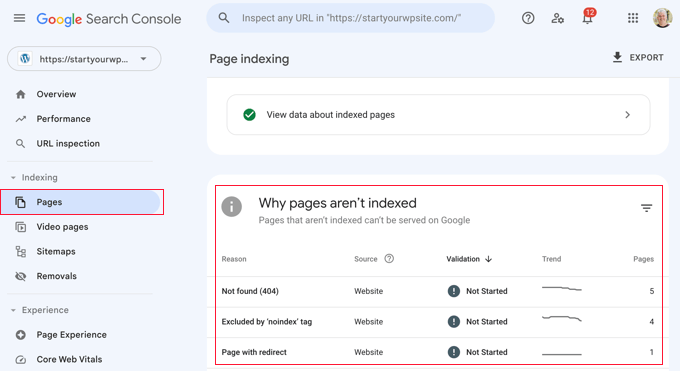
Per ulteriori informazioni, puoi leggere il nostro elenco di suggerimenti per l'utilizzo di Google Search Console per aumentare il traffico del sito web, che include alcuni suggerimenti su come correggere gli errori 404 con lo strumento.
Detto questo, vediamo come correggere i post di WordPress che restituiscono errori 404. Puoi utilizzare i link sottostanti per passare direttamente a diverse soluzioni:
- Metodo 1: Verifica conflitti di plugin o temi e problemi di codice personalizzato
- Metodo 2: Correggi le impostazioni dei tuoi Permalink
- Metodo 3: Aggiorna il file .htaccess di WordPress
- Metodo 4: Contatta il tuo provider di hosting
- Method 5: Enable mod-rewrite (Local WordPress Installation)
- Domande frequenti sugli errori 404 di WordPress
- 🎁 Bonus: Guida aggiuntiva sulla gestione degli errori 404
Metodo 1: Verifica conflitti di plugin o temi e problemi di codice personalizzato
A volte, plugin, temi o codice personalizzato che hai aggiunto al tuo sito web WordPress possono interferire con i permalink o causare conflitti, portando a errori 404. L'abbiamo sperimentato anche noi stessi quando testiamo strumenti sul nostro sito demo.
Un modo per risolvere questo problema è disattivare temporaneamente i plugin. I plugin a volte possono interrompere il modo in cui WordPress gestisce i link.
Una volta disattivati i plugin, puoi riattivarli uno per uno controllando se l'errore 404 ricompare dopo aver attivato ciascun plugin. Se l'errore si presenta dopo aver attivato un plugin specifico, quello potrebbe essere il colpevole.
Puoi quindi effettuare una rapida ricerca su Google per trovare soluzioni relative a quel plugin o contattare lo sviluppatore del plugin per assistenza.
Allo stesso modo, il tuo tema WordPress potrebbe causare il conflitto.
Per verificarlo, puoi passare temporaneamente a un tema WordPress predefinito come Twenty Twenty-Three o Twenty Twenty-Four. Tutto ciò che devi fare è andare su Aspetto » Temi e fare clic su 'Attiva' su un tema predefinito.

Se l'errore 404 scompare con il tema predefinito, ciò indica un potenziale conflitto con il tuo tema attuale. Puoi quindi provare a risolvere i problemi del tema o considerare l'utilizzo di un tema diverso.
Puoi consultare la nostra selezione di esperti dei temi WordPress più popolari per raccomandazioni.
Se hai recentemente inserito snippet di codice sul tuo sito web, potrebbero esserci errori nel codice che causano gli errori 404. Dai un'occhiata attenta al codice che hai aggiunto e vedi se riesci a identificare eventuali errori.
Il modo più sicuro per aggiungere snippet di codice a WordPress è con il plugin WPCode. Questo plugin ti consente di inserire codice personalizzato senza lavorare direttamente con i file del tema, riducendo il rischio di compromettere il tuo sito web.
Inoltre, ogni volta che WPCode rileva un errore nel tuo codice, disattiverà automaticamente lo snippet e ti chiederà di controllarlo. Puoi anche utilizzare la modalità di test per verificare se il tuo codice funziona prima di pubblicarlo sul tuo sito web live.

Se nessuna di queste soluzioni funziona, passa al metodo successivo in cui risolveremo i problemi relativi alle impostazioni dei tuoi permalink.
Metodo 2: Correggi le impostazioni dei tuoi Permalink
I post di WordPress possono restituire errori 404 a causa di problemi con le regole di riscrittura nel tuo file .htaccess. Nella maggior parte dei casi, puoi risolvere il problema aggiornando le impostazioni dei tuoi permalink.
Vai semplicemente su Impostazioni » Permalink nella tua bacheca di WordPress e fai clic sul pulsante 'Salva modifiche'.

Non è necessario apportare modifiche alle impostazioni dei permalink stesse. Questo aggiornerà le tue impostazioni dei permalink e svuoterà le regole di riscrittura.
Nella maggior parte dei casi, questa soluzione risolve l'errore 404 dei post di WordPress. Tuttavia, se non funziona per te, probabilmente dovrai aggiornare manualmente il tuo file .htaccess.
Metodo 3: Aggiorna il file .htaccess di WordPress
Prima di iniziare, assicurati di eseguire il backup del tuo file .htaccess di WordPress. Se qualcosa va storto, puoi facilmente ripristinare il file originale.
Ora dovrai connetterti al tuo server utilizzando un client FTP come FileZilla o il File Manager nel tuo pannello di controllo di hosting.
Successivamente, trova il file .htaccess nella cartella principale del tuo sito: questa è la stessa directory che contiene cartelle come /wp-content/ e /wp-includes/.
Fai clic destro sul file e seleziona 'Permessi file' o 'Cambia permessi' dal tuo client FTP.
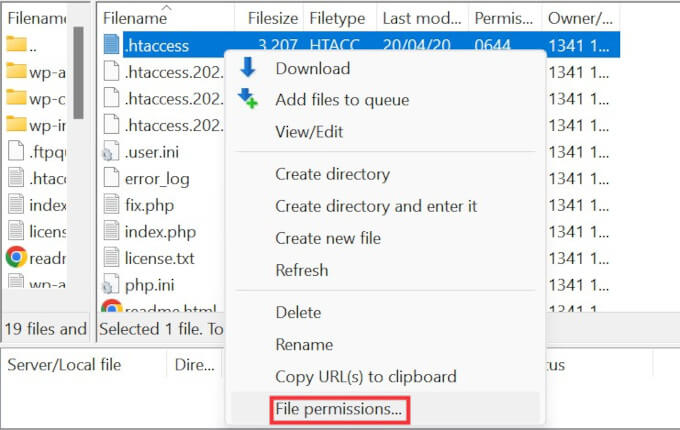
Se WordPress non è riuscito a scrivere sul file in precedenza, prova a cambiare temporaneamente i suoi permessi a 666 per renderlo scrivibile.
Dopodiché, torna all'area di amministrazione di WordPress e salva nuovamente le impostazioni dei tuoi permalink. Questo consente a WordPress di rigenerare un file .htaccess corretto.
Una volta fatto, assicurati di reimpostare i permessi del file a un'impostazione più sicura: 644. Questa impostazione consente a WordPress di leggere il file, proteggendolo comunque da modifiche non autorizzate.

In alternativa, puoi modificare manualmente il file.
Fai semplicemente clic destro sul file .htaccess e quindi seleziona l'opzione Visualizza/Modifica.
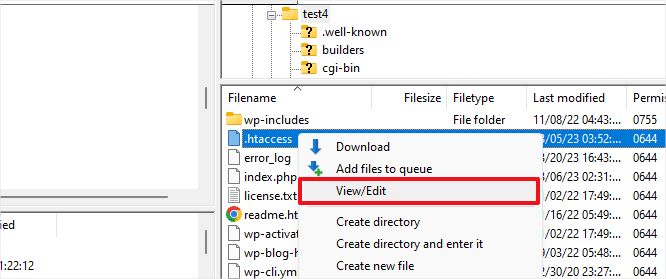
Il file si aprirà in un editor di testo semplice come Blocco note o TextEdit.
Ora devi aggiungere le seguenti regole di riscrittura predefinite di WordPress:
# BEGIN WordPress
<IfModule mod_rewrite.c>
RewriteEngine On
RewriteBase /
RewriteRule ^index\.php$ - [L]
RewriteCond %{REQUEST_FILENAME} !-f
RewriteCond %{REQUEST_FILENAME} !-d
RewriteRule . /index.php [L]
</IfModule>
# END WordPress
Metodo 4: Contatta il tuo provider di hosting
Se nessuna delle soluzioni sopra ha risolto l'errore 404 dei post di WordPress, ti consigliamo di contattare il tuo provider di hosting WordPress. Potrebbe esserci un errore da parte loro o potrebbero essere in grado di aiutarti a risolvere il problema.
Consulta anche la nostra guida su come chiedere correttamente supporto per WordPress e ottenerlo.
Metodo 5: Abilita mod-rewrite (Installazione WordPress locale)
Se stai utilizzando un server locale per scopi di test, dovrai abilitare mod_rewrite nella configurazione Apache del tuo sito MAMP, WAMP o XAMPP.
Questo consentirà a WordPress di generare URL puliti e prevenire l'errore 404 per post e pagine sul tuo server locale.
Il modo in cui lo farai differirà a seconda della piattaforma che utilizzi. Le persone che usano XAMPP possono aprire il loro pannello di controllo e fare clic sul pulsante 'Config' in Azioni. Quindi, seleziona 'Apache (httpd.conf)'.
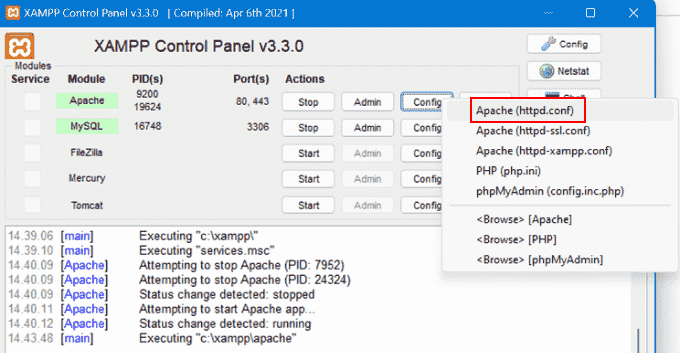
Successivamente, dovrai trovare questa riga #LoadModule rewrite_module modules/mod_rewrite.so e rimuovere il '#' per decommentarla.
Questo caricherà il mod_rewrite.
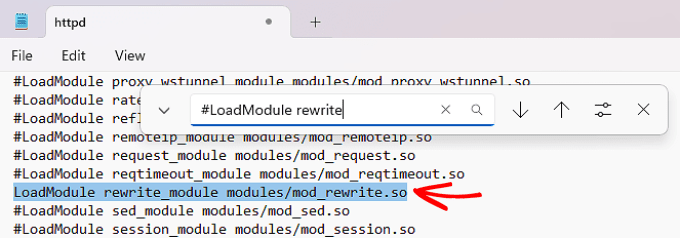
Quindi, cerca le righe che dicono AllowOverride None e cambiale in AllowOverride All. Questo dice ad Apache di consentire l'uso dei file .htaccess.
Di solito li trovi all'interno dei blocchi <Directory>, specialmente quello che punta alla cartella del tuo sito, come htdocs se stai usando XAMPP. Se non sei sicuro, va bene applicare la modifica ovunque la vedi all'interno del file, purché non si tratti di una directory di sistema. Per il testing locale, questo di solito funziona benissimo.

Una volta fatto, puoi salvare il file httpd.conf e chiuderlo. Successivamente, nel pannello di controllo di XAMPP, fai clic su 'Stop' sul modulo Apache e di nuovo su 'Start' per riavviarlo.
Quindi, torna alla tua bacheca di amministrazione per vedere se i tuoi permalink funzionano.
Tutorial video
Se hai bisogno di istruzioni visive, guarda il video qui sotto.
Domande frequenti sugli errori 404 di WordPress
Incontrare errori 404 sul tuo sito WordPress può essere fonte di confusione. Di seguito, abbiamo risposto a domande comuni che possono aiutarti a risolvere e correggere il problema in modo più efficace.
1. Perché ricevo un errore 404 sui miei post di WordPress?
Questo di solito significa che WordPress non riesce a trovare il post all'URL richiesto. Può accadere a causa di permalink interrotti, un file .htaccess corrotto, post eliminati o un conflitto di plugin/tema che modifica la gestione degli URL.
2. Come risolvo un errore 404 in WordPress?
Prova a salvare nuovamente le impostazioni dei tuoi permalink andando su Impostazioni » Permalink e facendo clic su 'Salva modifiche'. Se ciò non funziona, controlla il tuo file .htaccess, disabilita i plugin o passa a un tema predefinito per escludere conflitti.
3. Come posso trovare tutti gli errori 404 sul mio sito WordPress?
Puoi utilizzare Google Search Console per vedere un elenco di errori 404 che Googlebot incontra. Plugin come Broken Link Checker possono anche aiutare a individuare link interrotti e pagine mancanti all'interno del tuo sito.
4. Cosa fa il file .htaccess in WordPress?
Il file .htaccess controlla come vengono elaborati gli URL. WordPress lo utilizza per gestire la struttura dei permalink e instradare gli URL al contenuto corretto. Se è mancante o corrotto, gli URL potrebbero smettere di funzionare correttamente.
5. Come modifico in sicurezza il file .htaccess?
Puoi modificarlo usando un client FTP o il file manager del tuo hosting. Esegui sempre un backup prima. Dopo la modifica, assicurati che i permessi siano impostati su 644 in modo che rimanga leggibile e sicuro.
6. Perché le mie pagine di categoria o tag di WordPress mostrano errori 404?
Questo può accadere se il tuo tema non supporta i modelli di archivio o se le impostazioni dei permalink sono configurate in modo errato. Salvare nuovamente i permalink e verificare il supporto dell'archivio del tuo tema può aiutare a risolvere il problema.
7. Come posso correggere gli errori 404 per i tipi di post personalizzati?
Visita Impostazioni » Permalink e fai clic su 'Salva modifiche' per aggiornare le regole di riscrittura. Inoltre, verifica che il tuo tipo di post personalizzato sia registrato con le giuste impostazioni di riscrittura e abbia il supporto dell'archivio, se necessario.
8. Posso reindirizzare le pagine 404 alla mia homepage o a un'altra pagina?
Sì, plugin come Redirection ti consentono di creare reindirizzamenti 301 da URL vecchi o non funzionanti a quelli nuovi. Puoi anche creare una pagina 404 personalizzata per guidare gli utenti verso contenuti utili.
🎁 Bonus: Guida aggiuntiva sulla gestione degli errori 404
Potresti trovare utili anche le seguenti risorse per la gestione degli errori 404 e altri errori comuni di WordPress.
- Come migliorare il tuo template di pagina 404 in WordPress (2 modi)
- I migliori esempi di design di pagine di errore 404 per WordPress
- I migliori plugin gratuiti per reindirizzare gli errori 404 per WordPress
- Come ricevere avvisi via email per errori 404 in WordPress
Speriamo che questo articolo ti abbia aiutato a risolvere i post che restituiscono errori 404 in WordPress. Potresti anche voler consultare la nostra guida agli errori WordPress più comuni e come risolverli, insieme alle nostre scelte esperte per i migliori plugin WordPress per far crescere il tuo sito.
Se ti è piaciuto questo articolo, iscriviti al nostro canale YouTube per tutorial video su WordPress. Puoi anche trovarci su Twitter e Facebook.





Thomas Elkin II
Sfortunatamente, questo non mi ha aiutato. Nessuna delle due soluzioni ha funzionato. Qualcuno ha altri suggerimenti?
Sharma Rahul
Grazie, grazie mille!! Mi hai salvato la serata (y)
Javier Rodriguez
Waooo. Una settimana a cercare di capire cosa non andava ed era il problema WAMP. Risolto con un clic. Grazie mille
Ben
Grazie. Consigli chiari che mi hanno risparmiato molte ore di panico.
Milano
Trovato soluzioni su molti siti... Ma senza fortuna. E dopo tutto ho provato quanto segue
Impostazioni » Permalink, e fai semplicemente clic sul pulsante Salva modifiche.
Ha funzionato!!
Million Thanks To Team WpBeginner….. !!
minacio
Grande aiuto, grazie mille!
So easy!
Jeff
Temo che questo non abbia funzionato per me. Continuo a ricevere l'errore 404 e questo influisce su tutti i link della mia pagina principale. Tuttavia, se imposto le impostazioni dei Permalink su "Predefinito", tutto funziona. Non voglio però le impostazioni predefinite, voglio che i permalink utilizzino "Giorno e nome". Ho anche controllato il file .htaccess e va bene. Ho fatto lo stesso per i permessi e anche quelli vanno bene. Aiuto!
Supporto WPBeginner
Jeff, hai provato a eliminare il tuo file .htaccess? Dopo averlo eliminato, devi andare su Impostazioni » Permalink e salvare le impostazioni dei permalink desiderate.
Amministratore
Rick Harris
Quindi questo suggerimento funziona solo in parte per me. Ho il problema del 404 solo su 1 post, ma è il mio primo, quindi è quello che spiega 'di cosa parla questo blog e cosa troverai qui', quindi è piuttosto importante per il sito del blog.
Vedi se riesci a capirlo.
Se imposto i permalink su qualcosa come anno/mese/nome del post, funziona bene.
Anche se vado a eliminare il file htaccess e poi apporto la modifica, impostandolo su 'nome del post' si verifica che quel post ottenga il 404. Verrà comunque visualizzato nelle pagine principali e di categoria, però.
Alejandro
Thanks!!! …fixing the Permalinks did it for me! (;
…fixing the Permalinks did it for me! (;
Gaston
Ah ah, così facile! grazie!
Indonesian
Davvero utile.. grazie mille... Sei un grande uomo.. !!
Annie
Ho esaminato entrambe queste opzioni e continuo a ricevere un errore 404. Ho impostato i permalink su 'nome articolo', ma per qualche motivo solo UNO dei miei articoli è bloccato su una struttura di permalink diversa (l'articolo termina con /3088 invece) e non cambia quando aggiorno i permalink. Sono anche entrato nel mio file .htaccess e c'era già il codice che avevi sopra, ma non c'era nulla riguardo ai permessi nel file. C'è qualcosa che posso fare per far apparire questo articolo? Posso vederlo nel feed della mia homepage, ma ricevo l'errore quando ci clicco sopra per andare alla pagina dell'articolo.
Ashleigh
Sto avendo lo stesso problema... AIUTO
Scotty
sììì. grazie per questo post – mi ha davvero salvato la vita!
Roel
Sei un boss.
Emily Gates
Grazie admin, ero molto preoccupato per questo, infatti ho installato un plugin per le categorie (perché gestisco il mio blog che è facebookstatuss.com) e dopo la disattivazione ho scoperto che il mio singolo articolo non veniva mostrato correttamente, veniva visualizzato un errore 404, ma ora l'ho risolto. Grazie per aver fornito la soluzione.
Marx
Amico, sei un grande.
Amon Lucas
Grazie! Obrigado.
Somesh
Ho cambiato il mio tema per un po'. E ha diverse sezioni predefinite nella dashboard.
Gadget
Videogiochi
Come fare
Quindi, dopo aver riapplicato di nuovo il tema, i post nella sezione post funzionano bene. Ma, i post per quelle sezioni dicono pagina non trovata.
Come riportare quei post indietro i post sono disponibili nella dashboard ma, anche le loro miniature sono disponibili sul sito web ma quando ci clicco sopra dice pagina non trovata.
sven
grazie mille. mi hai reso la giornata.
Naser
Grazie mille. Mi hai reso la giornata. Grazie……
Edgar
Thanks for the info! Was in dispair, but now fine again. Had to do an extra step though. My host provider (hostnet) installed wordpress for me, so I had to get into their config panel to sync the .htacces file. Don’t know if this is more common for people using pre installed wordpress. Just letting you know
Markus Dan
Questo è geniale!
Grazie... mi hai salvato la giornata!
Dani
Ehi amico, grazie mille. Mi hai risparmiato un sacco di ore di lavoro!
Carl
Ciao,
il mio problema era che il file .htaccess non era scrivibile.
Tutto quello che dovevo fare era impostare il chmod a 777, poi premere il pulsante "salva modifiche" nel menu Opzioni Permalink. WP ha quindi svuotato correttamente le vecchie impostazioni di .htaccess e le ha riscritte.
Funziona, Grazie!
Ben
Ciao, ho avuto lo stesso problema su 2 dei miei siti con la modifica di post o pagine, tutto il resto sembrava funzionare bene. (è successo contemporaneamente)
L'ho risolto cambiando i permessi in cpanel/file manager a 644 per i file e 755 per le directory e tutto è tornato alla normalità. quindi controlla il tuo hosting per le impostazioni consigliate sui permessi dei file.
In qualche modo i permessi per tutti i file e le directory erano impostati su 655 per (tutti i file e le directory di wp).
Cambiare i permessi solo sul file .htaccess non ha funzionato per me e nemmeno modificarlo, né cambiare i permalinks. {in qualche modo penso che il mio problema provenisse dal mio server.}
Spero sia utile per qualcuno.
Pankaj Chauhan
Stavo ricevendo lo stesso errore 404 sul mio blog. Non succedeva con tutti i post ma con uno specifico. Dopo qualche ora ho notato che il nome della categoria causava il problema. quindi ho eliminato la categoria e l'ho ricreata con uno slug diverso. Ha funzionato.
ma non sono ancora sicuro del perché sia successo...
Fortunatamente, in quella categoria, non avevo post altrimenti... sarebbe stato un problema dato che dovevo riassegnare la nuova categoria a tutti i post.
JP van der Meer
Grazie mille, mi ha aiutato!
I did delete the .htaccess
Grazie!
Manisha Sarangi
Ciao,
Ho un'altra soluzione e ha funzionato come per magia.
Segui solo pochi passaggi qui.
Per UBUNTU :
1.Devi abilitare mod_rewrite nel server Apache
sudo a2enmod rewrite
2.Devi riavviare il webserver per applicare le modifiche
sudo service apache2 restart
3. Se si prevede di utilizzare mod_rewrite nei file .htaccess, è anche necessario abilitare l'uso dei file .htaccess modificando AllowOverride None in AllowOverride FileInfo. Per il sito web predefinito, modificare /etc/apache2/sites-available/default
Opzioni Indici FollowSymLinks MultiViews
# cambiato da None a FileInfo
AllowOverride FileInfo
Order allow,deny
allow from all
4.Dopo una tale modifica, è necessario riavviare nuovamente Apache
sudo service apache2 restart
5. Quindi vai su admin di wordpress>impostazioni>permalink>seleziona nome post e salva le modifiche
Ora funzionerà.
Grazie
David Vitorino
Grazie per questo post!!
Stavo cercando di installare wordpress su koding.com VPS e il tuo post mi ha davvero aiutato.
la mod_rewrite era disattivata in apache.
Complimenti
seb okelly
Questo post ha risolto il mio problema, che avevo peggiorato armeggiando nel Codex. Grazie.
Syl
Ciao!
Grazie per il tuo post. Ho un problema simile sul mio blog WordPress e non so cosa fare al momento. Per farla breve, il mio file .htaccess viene sovrascritto più e più volte...
Queste righe:
# BEGIN WordPress
RewriteEngine On
RewriteBase /
RewriteRule ^index\.php$ – [L]
RewriteCond %{REQUEST_FILENAME} !-f
RewriteCond %{REQUEST_FILENAME} !-d
RewriteRule . /index.php [L]
# END WordPress
vengono duplicate centinaia o migliaia di volte con caratteri NUL, e il mio .htaccess ora è di 1,5 Mo! Posso risolvere il problema caricando un .htaccess pulito, ma il problema si ripresenta dopo poche ore/giorni, ancora e ancora, e le pagine dei miei siti mostrano solo un errore 404...
Ho anche provato a impostare gli attributi del file htaccess su 404 invece di 604 per impedirne la riscrittura, ma il mio host non lo consente e è tornato a 604...
Wordpress: 3.6.1 Plugin: Akismet, Anti-spam, DB Cache Reloaded Fix, Do Follow, Google Analytics for WordPress, Post Ratings, Recipe Card, Tweet, Like, Google +1 and Share, UberMenu, WordPress Database Backup, WordPress SEO, WP Sitemap Page, WP Super Cache
Qualche idea?
Best regards
Supporto WPBeginner
Disattiva tutti i tuoi plugin, se hai del codice personalizzato incollato nel file functions.php del tuo tema, crea un backup del tuo file esistente e poi installa una copia fresca del tuo tema. Elimina il tuo file .htaccess. Vai su Impostazioni » Permalink e salva i tuoi permalink. Ora connettiti al tuo sito tramite FTP, wordpress avrà creato un nuovo file .htaccess per te. Naviga alcune pagine sul front-end del tuo sito e poi vedi se le modifiche nel tuo file .htaccess riappaiono.
Amministratore
MissyLee
Many many thanks for continuing with helping people – My child theme functions.php was the problem. Seriously, this is a great site!
Megha Verma
Ciao, ho un problema di errore 404 pagina non trovata. Ma non è applicabile a tutti i post. Questo problema si presenta in 5 casi su 10. Inoltre, sto usando lo stesso metodo per creare tutti i post e la struttura dei permalink è /sample-post/. Per favore, aiutami a risolvere questo problema e forniscimi la soluzione migliore.
Ana Villegas
Fantastico! Questo mi ha aiutato molto, grazieeeee! <3
Biswajit Rout
Ciao,
Grazie per le informazioni. Ho lo stesso problema.
Ma ora l'ho risolto aggiungendo il codice seguente nel mio .htaccess.
# BEGIN WordPress
RewriteEngine On
RewriteBase /
RewriteRule ^index\.php$ – [L]
RewriteCond %{REQUEST_FILENAME} !-f
RewriteCond %{REQUEST_FILENAME} !-d
RewriteRule . /index.php [L]
# END WordPress
Grazie ancora per questo post.
Jyo
Hi, thanks for the info, but it doesnt work for me Please admin can you help me out. My permalinks arent working. I have tried your method. The only way its working is by setting permalinks to default else the whole site comes down, not even the wp admin section is accessible.
Please admin can you help me out. My permalinks arent working. I have tried your method. The only way its working is by setting permalinks to default else the whole site comes down, not even the wp admin section is accessible.
Supporto WPBeginner
Ecco qualcosa che puoi provare. Connettiti al tuo sito WordPress usando un client FTP come Filezilla. Una volta connesso al tuo sito web, nella barra dei menu di Filezilla fai clic su Server » Forza visualizzazione file nascosti. Trova il file .htaccess nella directory principale del tuo sito web, scaricalo sul tuo computer, quindi elimina il file dal tuo server. Ora vai nell'area di amministrazione di WordPress nel tuo browser e fai clic su Impostazioni » Permalink. Scegli una struttura di permalink per il tuo sito web e fai clic sul pulsante Salva modifiche. Speriamo che questo risolva il tuo problema.
Amministratore
Elizabeth
Questo errore 404 mi stava facendo impazzire!. Grazie per queste informazioni istruttive!
Decio Denis Bernardo
Grazie.. bello e facile!
karen
Pensavo di aver già combinato un pasticcio con il mio blog e di non poterlo più far funzionare. Grazie per questo bel post!
Darren
Sei FANTASTICO! Non avevo idea di cosa non andasse. 5 minuti di lettura del tuo post e qualche clic dopo il mio blog è di nuovo online e funzionante! Grazie mille!
Gav Reichel
Se tutto quanto sopra non fa alcuna differenza per te, potrebbe valere la pena chiedere all'amministratore del tuo sito web se ha aggiunto quanto segue alla configurazione (se si utilizza Apache):
Opzioni Indici Includi FollowSymLinks
AllowOverride All
(Questo è solitamente definito nella sezione dell'host virtuale)
In caso contrario, il tuo file .htaccess non verrà letto!
(Parlo per esperienza dopo aver passato 30 minuti a cercare di capirlo!)
pete
Ciao, il mio htaccess è stato hackerato e ho dovuto eliminarlo. Ora ho questo problema. Questa soluzione mi porta solo a metà strada. Dal messaggio 404 del browser (prima) alla mia pagina 404 personalizzata di WordPress (dopo il ripristino dei permalink). Qualche idea?
Staff editoriale
Riesci a vedere che il .htaccess viene creato? In caso contrario, potresti voler aggiungere un file .htaccess vuoto.
Amministratore
Pete
Took me a while to get back…
The htaccess look allright. It gets updated..Still not working. Only the custom ugly permalinks. Another wp site on the same server got hacked at the same time. But on that one this fix solves the problem..
protik
Thank you Thank you so much…had a mild panic attack when the 404 error happened…this post was a life saver!!
Rod Salm
Permalink fix worked for me, thank you very much!
Rod Salm
Peter
Grazie grazie grazie.
Ha funzionato.
Hai ragione, ci sono così tante variabili che a volte sapere cosa chiedere è significativamente più difficile che risolvere il problema.
Ora posso accedere di nuovo al mio blog.
Buona giornata.
Peter Sitting Scribe
Allii Allee
Ho fatto tutti i passaggi ma mi dà ancora questo errore
Errore 404
La pagina richiesta non può essere visualizzata. Sembra che tu abbia perso la tua destinazione prevista, a causa di un link errato o obsoleto, o di un errore di battitura nella pagina che speravi di raggiungere.
Akhil Gupta
prima di tutto voglio ringraziarti per questo fantastico tutorial.. non riesco a cambiare il permalink da 2 ore.. stavo modificando il file .htaccess ma non funzionava, ma dopo aver visto il tuo post sull'errore 404 sono riuscito a capirlo e ora il mio problema è risolto. Grazie ancora
SBC
Grazie, mi ha davvero aiutato a risolvere i problemi con il mio sito...
Bruce Ketchum
Grazie, WPBeginner! Il tuo suggerimento di fare clic sul pulsante Salva modifiche nelle impostazioni dei Permalink di WordPress ha risolto il mio errore 404, che si verificava su post e pagine.
Imran Hossain
Questo è un tutorial molto importante per me. Oggi ho imparato l'errore 404 Not found.
Adrian D'Amico
Anch'io ho questo problema su un mio sito – dove continua a succedere ogni pochi giorni anche dopo aver fatto clic su Salva modifiche e aggiornato i Permalink. Suppongo che sia un plugin, ma non ho ancora disattivato e riattivato tutti i plugin perché dovrei aspettare giorni per scoprire quale lo sta causando. Pensi che la soluzione di modifica di htaccess che descrivi sia una soluzione permanente, o il problema si ripresenterà? Grazie per qualsiasi aiuto tu possa fornire.
Staff editoriale
Ogni sito WordPress che utilizza permalink personalizzati ha quel codice.
Amministratore
Adrian
Ciao – Ho seguito questo tutorial ma il mio sito è ancora afflitto da questo problema. C'è qualcosa che lo scatena? Qualcosa come un plugin? Ho ricontrollato e il mio file htaccess è sempre come suggerisci nell'articolo, sembra che stia succedendo qualcos'altro almeno nel mio caso. grazie per qualsiasi aiuto tu possa fornire.
Adrian
Suppongo che quello che sto chiedendo è se conosci un modo per rintracciare cosa lo sta causando (cioè, quale plugin, ecc.)
Rich
Hai questo in httpd.conf per i file del webserver – circa alla riga 220 in un file httpd.conf predefinito. Il tuo host potrebbe sovrascrivere le modifiche che hai apportato?
AllowOverride FileInfo
Le impostazioni del mio webserver non lo avevano, quindi nonostante l'avessi modificato nelle impostazioni iniziali della Directory, semplicemente non funzionava. Appena l'ho fatto ha funzionato.
Jay Castillo
La domanda è, cosa sta causando il problema con il file htaccess?
Ho riscontrato questo problema prima e l'ho ricondotto all'uso del plugin wordpress diggdigg.
La soluzione rapida è stata salvare la struttura dei permalink proprio come hai menzionato sopra, ma il problema mi è capitato due volte (errori 404 sui miei post del blog, la homepage andava bene) in una settimana e dopo aver rimosso il plugin diggdigg, non si è più verificato.
Non so ancora perché sia successo.